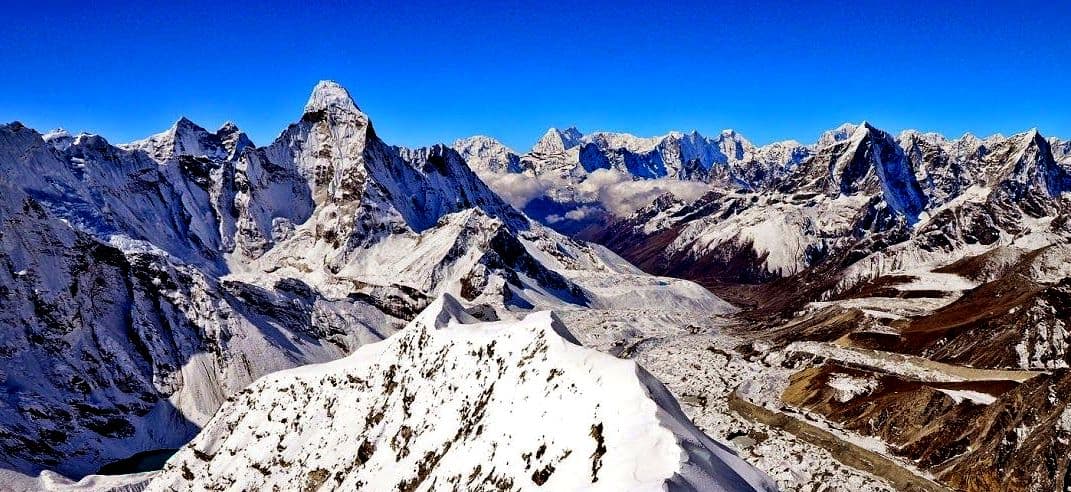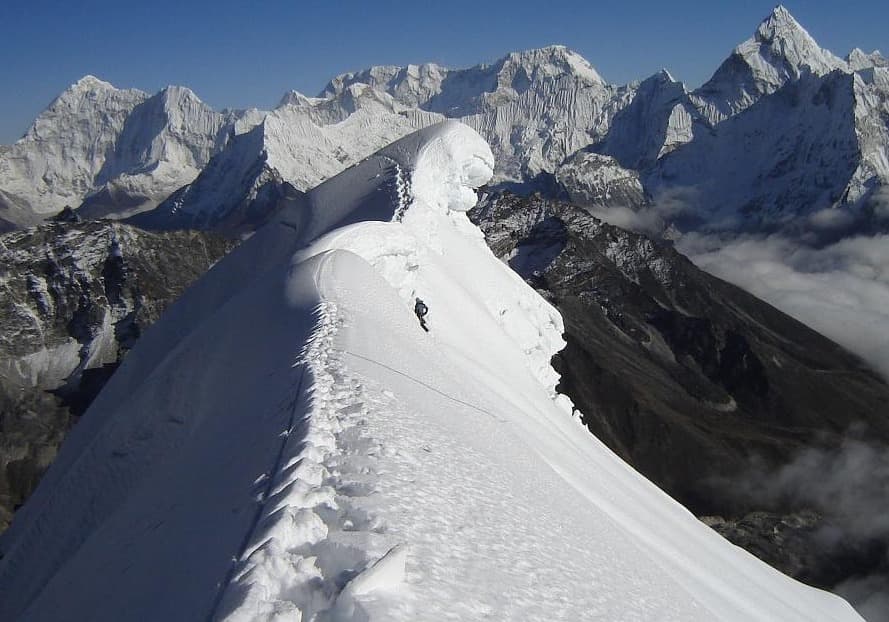Island Peak Climbing
We've designed this complete guide for ambitious trekkers ready to take their first serious step into technical mountaineering and experienced climbers seeking the perfect warm-up for bigger Himalayan challenges. Island Peak climbing offers that sweet spot where stunning Everest region trekking meets legitimate alpine climbing skills, creating an adventure that pushes your limits without overwhelming beginners to high-altitude mountaineering.
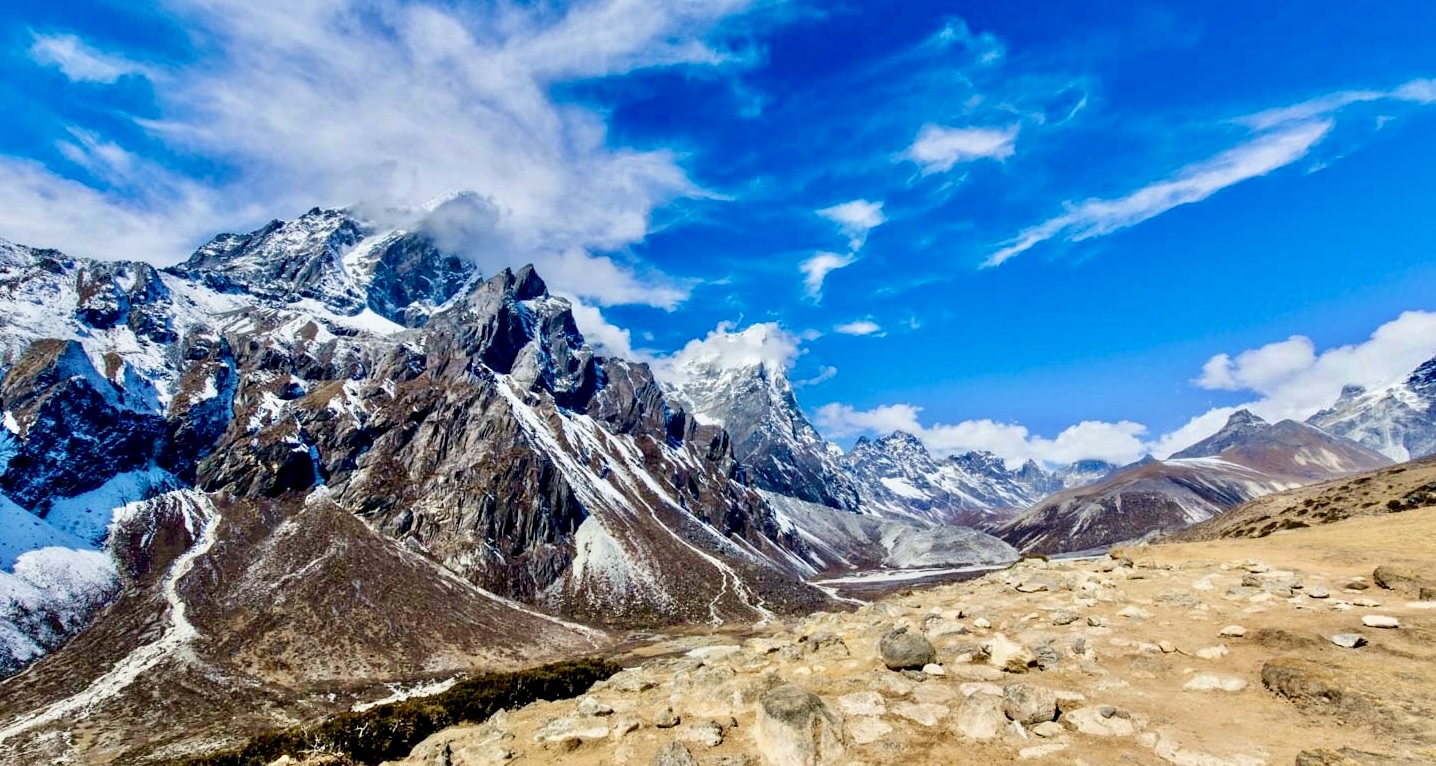
At Luxury Holiday Nepal, we've guided hundreds of climbers up this magnificent 6,189-meter peak, and we know exactly what separates successful summit attempts from disappointing retreats. This isn't just another trek – Island Peak demands real mountaineering techniques including rope work, crampon use, and ice axe skills, all while navigating the thin air above 6,000 meters.
We'll walk you through everything from understanding why Island Peak serves as the perfect gateway to high-altitude mountaineering to breaking down our detailed itinerary that maximizes your acclimatization and summit chances. You'll also discover the essential physical and technical preparation that sets successful climbers apart, plus get the inside scoop on our comprehensive service package that handles every logistical detail while you focus on the climb itself.
Here are some the perfect Island Peak Climbing Package for the Climber:-
Understanding Island Peak: The Perfect Gateway to High-Altitude Mountaineering
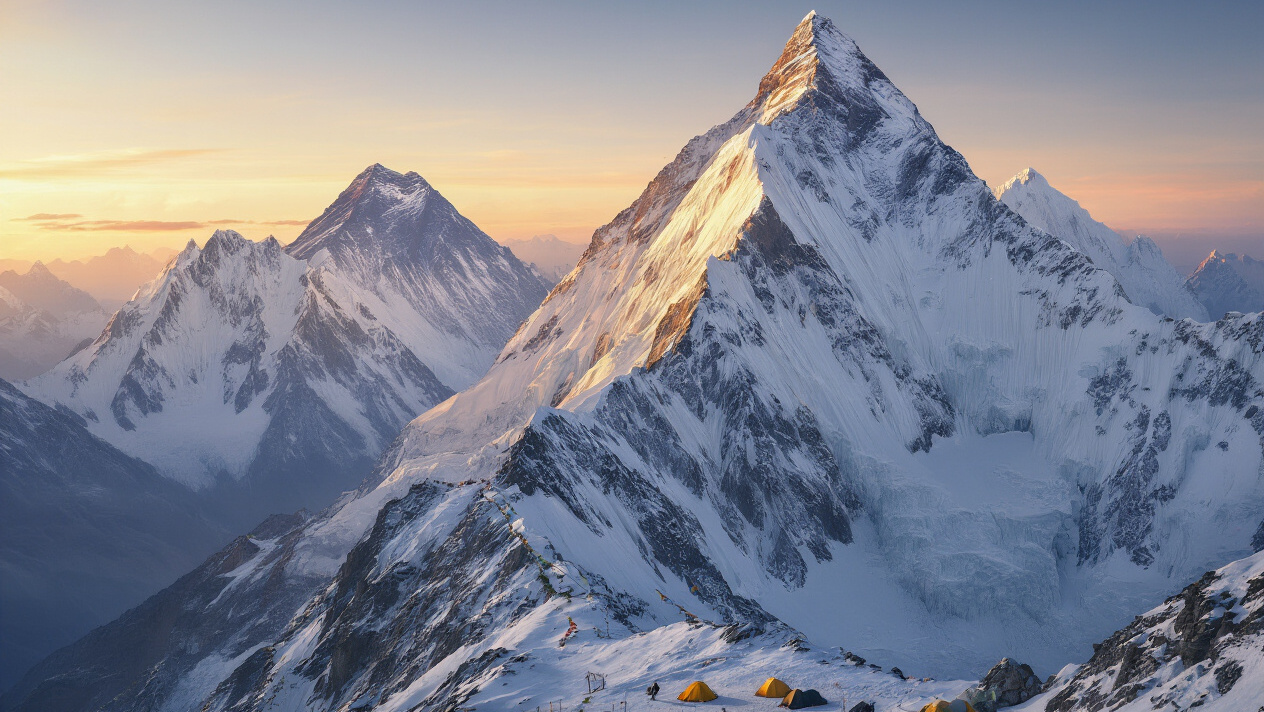
Why Island Peak is Ideal for First-Time Climbers
We've guided hundreds of climbers up Island Peak, and we can confidently say it's one of the best introductory 6,000-meter peaks in the world. At 6,189 meters, Island Peak offers genuine mountaineering challenges without the extreme technical difficulties found on higher peaks like Everest or Cho Oyu.
What makes Island Peak special for newcomers is its forgiving nature. The climbing sections are demanding enough to teach essential skills but not so technical that they overwhelm first-time mountaineers. We see climbers develop confidence as they navigate fixed ropes, cross crevasses, and manage their gear at altitude. The summit day typically takes 8-12 hours, giving climbers a real taste of high-altitude endurance without the multi-day summit pushes required on 8,000-meter peaks.
The location within the Everest region means we can combine serious mountaineering training with world-class trekking. Our clients get to experience the famous Sherpa culture, visit ancient monasteries, and walk through some of Nepal's most spectacular mountain scenery. This combination creates an adventure that satisfies both the mountaineer and the cultural explorer.
We also appreciate how Island Peak builds physical and mental resilience. The approach trek naturally acclimatizes climbers, while the technical sections teach rope work, crampon use, and ice axe techniques. Success here opens doors to bigger peaks while providing an incredible standalone achievement.
Technical Requirements vs Trekking Experience
We often get asked about the jump from trekking to mountaineering, and Island Peak represents that bridge perfectly. While regular trekking requires good fitness and determination, mountaineering demands technical skills that many trekkers haven't encountered before.
The technical skills we teach for Island Peak include:
-
Crampon proficiency: Walking confidently on steep ice and snow
-
Rope work: Understanding fixed lines and basic knots
-
Ice axe use: Self-arrest techniques and balance support
-
Glacier travel: Reading terrain and avoiding crevasses
-
High-altitude gear management: Handling equipment with thick gloves
Our experience shows that strong trekkers adapt quickly to these skills. We spend several days at base camp running technical workshops where climbers practice on nearby ice features. The beauty of Island Peak is that the technical sections are short enough that even nervous beginners can push through with proper preparation.
Fitness Requirements Comparison:
|
Trekking Background |
Island Peak Preparation Needed |
|
Regular day hikers |
6-8 months cardio + strength training |
|
Experienced trekkers (EBC level) |
3-4 months technical + fitness focus |
|
Multi-day backpackers |
2-3 months skill development |
Physical fitness remains crucial, but we emphasize that technical confidence often matters more than pure strength. We've seen incredibly fit athletes struggle with exposure while determined trekkers excel once they master the basics.
Elevation Profile and Acclimatization Benefits
We've structured our Island Peak expeditions around optimal acclimatization, and the elevation profile works beautifully for this purpose. The approach follows the classic Everest Base Camp route, which we consider one of the world's best natural acclimatization schedules.
Our standard elevation progression looks like this:
Days 1-3: Lukla (2,840m) to Namche Bazaar (3,440m)
Days 4-6: Tengboche (3,867m) with rest day
Days 7-9: Dingboche (4,410m) with acclimatization hike
Days 10-12: Chukhung (4,730m) and pre-climbing preparation
Days 13-14: Island Peak Base Camp (5,087m)
Day 15: Summit attempt (6,189m)
This profile gives our climbers multiple opportunities to "climb high, sleep low" - the golden rule of acclimatization. We typically see clients adjust well because the increases are gradual and include active rest days where we explore higher elevations before returning to sleep at lower camps.
The acclimatization benefits extend beyond just reaching the summit. Our clients often report feeling stronger and more confident at altitude than they expected. This preparation serves them well for future mountaineering objectives, whether that's attempting higher peaks or simply enjoying high-altitude trekking with greater comfort.
We monitor our climbers carefully throughout the approach, watching for altitude sickness symptoms and adjusting our schedule when needed. The flexible nature of the Island Peak itinerary allows us to add extra acclimatization days without compromising the overall expedition timeline.
Essential Physical and Technical Preparation for Success
Building Endurance Through Progressive Training
We believe that successful Island Peak climbing starts months before you even set foot in Nepal. Your cardiovascular fitness forms the foundation of everything we'll accomplish together on the mountain. We recommend beginning your training program at least 4-6 months before your expedition date.
Start with aerobic base building through hiking, running, or cycling for 45-60 minutes, 4-5 times per week. We've seen climbers struggle significantly when they skip this crucial phase. Gradually increase your training intensity by incorporating hill repeats, stair climbing, and loaded backpack hikes. Carry 15-20 pounds initially, building up to 30-40 pounds during longer training sessions.
Weekly Training Structure:
-
Monday/Wednesday/Friday: Cardio sessions (running, cycling, or elliptical)
-
Tuesday/Thursday: Strength training focused on legs, core, and back
-
Saturday: Long hike with weighted pack
-
Sunday: Active recovery (yoga or light walking)
We strongly emphasize altitude simulation training if you live at sea level. Spend time at higher elevations when possible, or consider altitude training masks during workouts. Your body needs time to adapt to reduced oxygen levels, and we want you feeling confident rather than gasping for breath at base camp.
Mastering Basic Mountaineering Skills
Technical skills separate successful climbers from those who turn back. We ensure every team member masters essential mountaineering techniques before attempting the summit push.
Rope work stands as your primary safety skill. Practice tying into climbing harnesses, belaying techniques, and basic knot systems. We use figure-eight follow-through knots, clove hitches, and prusik knots regularly during the climb. Spend time with these until muscle memory takes over.
Essential Skills Checklist:
-
Self-arrest with ice axe in various positions
-
Crampon walking techniques on different terrain
-
Basic ice climbing movements
-
Rope team travel procedures
-
Crevasse rescue fundamentals
Glacier travel requires specific movement patterns and awareness. We practice walking in crampons extensively, focusing on maintaining proper spacing to avoid catching points on clothing or equipment. Ice axe techniques become second nature through repetitive practice on varied terrain angles.
Many climbers underestimate the physical demands of wearing full mountaineering gear for 12+ hours. We recommend training hikes while wearing your complete climbing setup, including boots, crampons, harness, and pack.
Equipment Familiarization and Testing
Your gear becomes an extension of yourself during the climb, so we insist on thorough familiarity with every piece of equipment. Breaking in boots ranks as the most critical preparation step. Wear your mountaineering boots during training hikes to identify pressure points and ensure proper fit with mountaineering socks.
We provide detailed equipment lists, but personal items require individual testing and adjustment. Your sleeping system, clothing layers, and pack organization directly impact daily comfort and safety.
Critical Equipment Testing:
-
Sleeping bag temperature ratings in controlled conditions
-
Layering system effectiveness during various weather scenarios
-
Crampon compatibility with boots
-
Headlamp battery life and backup lighting
-
Water bottle insulation performance
Practice setting up and breaking down your tent system in various conditions. We often establish camps in wind, snow, or limited visibility. Fumbling with tent poles and guy lines wastes precious energy and creates dangerous delays.
Your personal first aid knowledge and kit familiarity could save lives. We cover basic wound care, altitude sickness recognition, and emergency protocols during our pre-climb briefings.
Mental Preparation for High-Altitude Challenges
Mountain climbing tests mental resilience as much as physical strength. We've guided climbers with exceptional fitness who struggled mentally, while others with moderate fitness succeeded through mental toughness and positive attitudes.
Visualization techniques help prepare for challenging sections and potential setbacks. Picture yourself moving confidently through technical terrain, managing difficult weather conditions, and pushing through fatigue during summit day. Mental rehearsal builds confidence and reduces anxiety when facing real challenges.
Mental Training Strategies:
-
Daily meditation or mindfulness practice
-
Positive self-talk development
-
Stress management techniques
-
Goal-setting and milestone recognition
-
Team dynamics and communication skills
We emphasize patience and flexibility throughout the expedition. Weather delays, route changes, and physical challenges require mental adaptability. Rigid expectations often lead to disappointment and poor decision-making.
Sleep deprivation and altitude effects cloud judgment and increase irritability. Prepare for cognitive challenges by practicing decision-making under stress during training. Simple problem-solving exercises while tired or cold simulate mountain conditions effectively.
Building trust in your team members and guides creates psychological safety nets. We foster supportive group dynamics through shared challenges and open communication throughout the journey.
Best Seasons and Weather Windows for Island Peak Climbing
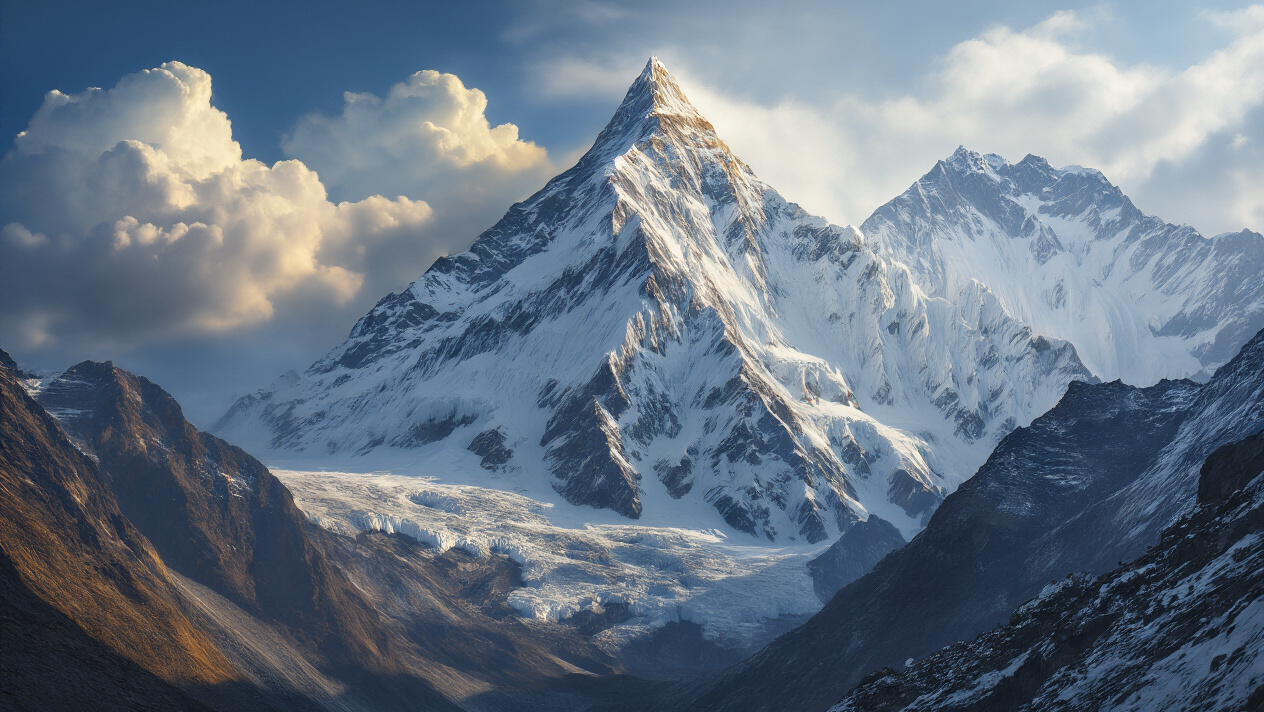
Spring Season Advantages and Considerations
Spring presents our most popular climbing window for Island Peak, typically spanning from March through May. During this period, we experience remarkably stable weather patterns with clear skies and moderate temperatures that create ideal conditions for both trekking and technical climbing sections.
The pre-monsoon stability gives us consistent weather windows, allowing for flexible summit attempts. We typically encounter daytime temperatures ranging from 5-15°C at base camp, while nights can drop to -10°C. The longer daylight hours provide extended climbing windows, giving us more margin for summit pushes and safe descents.
Spring brings several distinct advantages that we've observed over years of guiding expeditions. The snow conditions remain stable and well-consolidated from winter, providing secure footing on technical sections. The famous headwall section benefits from consistent snow quality that holds crampon placements effectively.
However, spring climbing requires careful consideration of increasing afternoon cloud buildup as we approach the monsoon season. We schedule our summit attempts for early morning starts, typically beginning our final push around 2-3 AM to ensure we reach the summit and return to high camp before weather deterioration.
The trail conditions during spring are generally excellent, with teahouses fully operational and well-stocked. We find that acclimatization progresses smoothly as the gradual temperature increase supports better adaptation to altitude changes.
Autumn Climbing Conditions
Autumn climbing season, extending from September through November, offers our second prime climbing window with distinctly different but equally favorable conditions. Post-monsoon clarity delivers some of the most spectacular mountain views of the entire year, with crystal-clear visibility extending for hundreds of kilometers.
We experience incredibly stable weather patterns during autumn, with minimal precipitation and consistent high-pressure systems. The monsoon rains have cleared all dust and pollution from the atmosphere, creating photographically perfect conditions. Daytime temperatures remain comfortable at 0-10°C at base camp, while nighttime temperatures can drop to -15°C or lower.
The autumn season presents unique advantages that many of our returning climbers specifically request. The mountain faces are generally free from fresh snow accumulation, exposing solid ice and rock that provides excellent technical climbing conditions. The headwall often presents blue ice sections that offer superb crampon and ice axe placements.
Wind patterns during autumn tend to be more predictable, with morning calms and afternoon thermals that rarely develop into dangerous conditions. We find that our summit success rates during autumn often exceed those of spring due to the extended periods of stable weather.
One consideration we always discuss with our clients is the colder overall temperature profile. While this creates excellent climbing conditions, it demands more sophisticated layering systems and higher-quality cold weather gear.
Weather Patterns and Safety Factors
Understanding Island Peak's microclimate patterns forms the foundation of our safety protocols and climbing strategies. We've developed comprehensive weather monitoring systems that track local conditions at multiple elevations, giving us real-time data for decision-making.
The mountain creates its own weather patterns due to its position in the Everest massif. We regularly observe rapid weather changes that can develop within hours, making our pre-climb briefings essential for client safety. Morning conditions often present calm, clear skies that can transition to afternoon cloud buildup and potential snowfall.
Our safety protocols include multiple weather checkpoints throughout each climbing day. We monitor barometric pressure, wind speed, cloud formation patterns, and temperature trends at regular intervals. This systematic approach allows us to make informed decisions about continuing climbs or implementing retreat strategies.
|
Weather Factor |
Spring Conditions |
Autumn Conditions |
Safety Considerations |
|
Temperature Range |
-10°C to 15°C |
-15°C to 10°C |
Hypothermia risk management |
|
Precipitation |
Low, late season increase |
Minimal |
Route conditions monitoring |
|
Wind Patterns |
Moderate, predictable |
Light, very stable |
Summit timing crucial |
|
Visibility |
Good, some haze |
Exceptional clarity |
Navigation advantages |
We maintain constant communication with our base camp team, weather services, and other expedition groups to ensure we have comprehensive situational awareness. Our guides carry satellite communication devices and weather monitoring equipment on all climbing sections above base camp.
The jetstream's position significantly influences conditions on Island Peak. When the jetstream sits high above the mountain, we experience calm conditions perfect for climbing. However, when it drops to mountain level, we encounter dangerous winds that make climbing impossible. We track jetstream forecasts as part of our weather analysis.
Detailed Itinerary: From Kathmandu to Summit and Back
Lukla Flight and Trek to Namche Bazaar
We begin our Island Peak adventure with the legendary flight to Lukla's Tenzing-Hillary Airport, one of the world's most thrilling airport landings. Our team coordinates morning flights to maximize weather windows, though we always build flexibility into our schedule since mountain weather can be unpredictable. After landing on Lukla's dramatic runway, we conduct final gear checks and meet our experienced Sherpa crew who will accompany us throughout the journey.
The trek from Lukla to Namche Bazaar spans approximately 8 kilometers and takes us through the heart of Sherpa country. We cross the famous Hillary Suspension Bridge over the Dudh Koshi River, offering our first spectacular views of the Everest region's towering peaks. Our route winds through pine forests and traditional Sherpa villages, giving us a gentle introduction to high-altitude trekking.
We typically complete this section in one day, arriving in Namche Bazaar by afternoon. This UNESCO World Heritage site serves as the gateway to the Everest region, and we use our time here to explore the Saturday market (when possible), visit the Sherpa Museum, and enjoy our first glimpse of Everest from the surrounding viewpoints. The gradual ascent to 3,440 meters helps our bodies begin the acclimatization process while we rest in comfortable lodges with mountain views.
Acclimatization Days in Dingboche and Chukhung
Our carefully planned acclimatization schedule includes strategic rest days in Dingboche at 4,410 meters and Chukhung at 4,730 meters. We never rush this critical phase because proper acclimatization directly impacts summit success rates. During our time in Dingboche, we take acclimatization hikes to Nagarjun Hill or Chhukhung Ri, following the golden rule of "climb high, sleep low."
In Chukhung, we position ourselves perfectly for Island Peak preparation. This small settlement sits in a dramatic valley surrounded by towering peaks including Lhotse, Nuptse, and our target, Island Peak itself. We use these days for technical skills refreshers, rope work practice, and crampon familiarization on nearby glacial terrain. Our guides assess each team member's technical abilities and provide personalized instruction.
We also conduct gear organization sessions, ensuring everyone's equipment fits properly and functions correctly. Our Sherpa team begins preparing advanced base camp supplies during these rest days. The combination of gradual altitude gain, skill building, and rest allows our bodies to produce more red blood cells and adapt to decreasing oxygen levels. We monitor everyone's health closely, using pulse oximeters and observing for altitude sickness symptoms.
Base Camp Setup and Summit Push Strategy
Our Island Peak Base Camp sits at 5,200 meters in a spectacular amphitheater of ice and rock. We establish this camp with military precision, choosing tent sites that offer protection from rockfall and avalanche zones. Our experienced Sherpa team sets up a comfortable camp with dining tents, sleeping quarters, and kitchen facilities that serve as our home for several days.
From Base Camp, we make a reconnaissance trip to High Camp at 5,600 meters, allowing us to scout the route, cache equipment, and gain additional acclimatization. This intermediate camp sits on a rocky outcrop overlooking the technical climbing sections above. We typically spend one night here before our summit push, timing our departure to reach the summit during optimal weather windows.
Our summit day begins around midnight, using headlamps to navigate the initial rock scramble and approach to the glacier. We rope up for the technical sections, including the famous headwall that requires fixed rope ascents and crampon work. Our guides maintain a steady pace that balances progress with safety, regularly checking team members' conditions and adjusting plans as needed. The final push involves steep ice climbing and exposed ridge walking to reach Island Peak's dramatic summit at 6,189 meters.
Descent and Return Journey Planning
We plan our descent with the same attention to detail as our ascent, recognizing that most mountaineering accidents occur during the descent phase. After celebrating on the summit and capturing photos with the incredible Everest, Lhotse, and Makalu backdrop, we begin our careful descent to High Camp, then continue to Base Camp the same day when conditions permit.
Our return journey to Lukla typically takes 3-4 days, following the same route but with adjusted pacing since we're descending and our bodies are well-acclimatized. We build buffer days into our itinerary to account for weather delays in Lukla, where flights can be postponed due to mountain conditions. These extra days also provide opportunities for celebration dinners and souvenir shopping in Namche Bazaar.
We maintain our commitment to Leave No Trace principles throughout the descent, ensuring all our waste is properly managed and removed from the mountain environment. Our Sherpa team dismantles camps completely, and we conduct final gear inventories to ensure nothing is left behind. Back in Kathmandu, we organize debriefing sessions and celebration dinners, giving everyone time to process their achievement and share experiences from this incredible journey that combines trekking through traditional Sherpa culture with technical mountaineering on one of Nepal's most accessible 6,000-meter peaks.
Technical Climbing Sections and Route Navigation
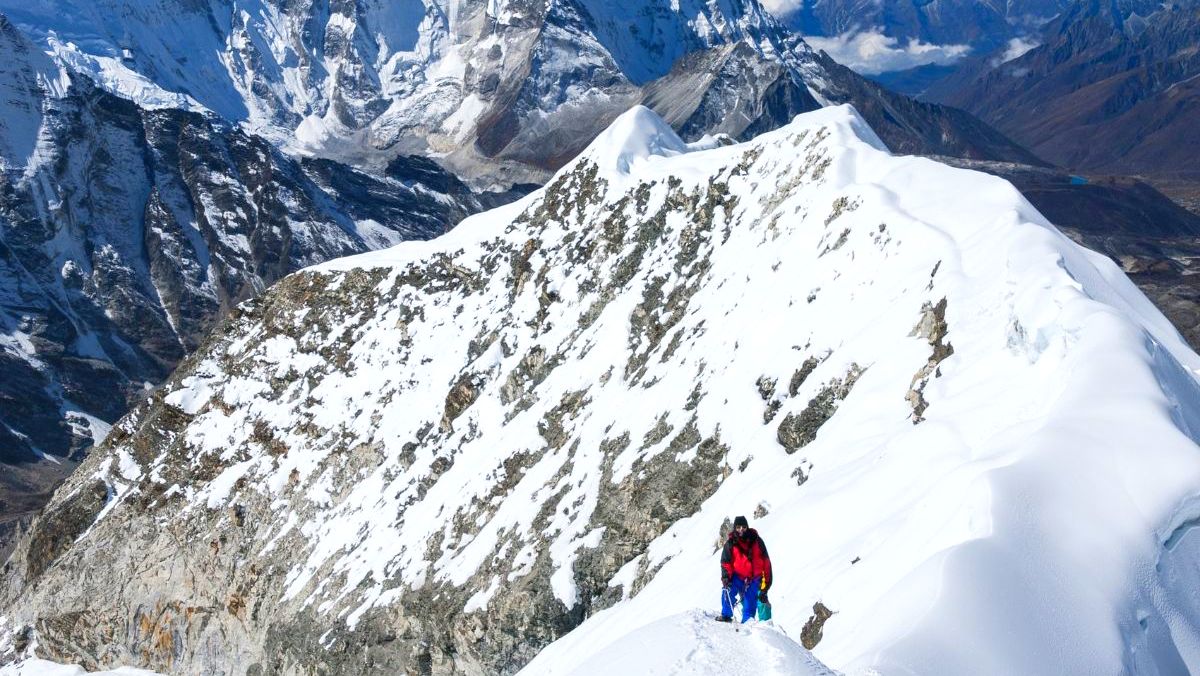
Glacier Travel and Crevasse Safety
Navigating the Island Peak glacier presents our first serious technical challenge. We cross numerous crevasses using aluminum ladders that our Sherpa team positions and secures daily. The glacier constantly shifts, creating new cracks and widening existing ones, so we stay roped together in teams of three to four climbers.
Our rope team techniques become critical here. We maintain proper spacing of about 30-40 feet between climbers, keeping the rope taut but not overly tight. When someone breaks through a snow bridge or slips, the team immediately arrests the fall using ice axes and body positioning.
We teach our climbers specific rescue techniques before reaching the glacier. Self-rescue with jumars and prusiks, team pulley systems, and Z-pulley hauls are all part of our safety protocol. We carry snow shovges, ice screws, and rescue gear specifically for crevasse scenarios.
The glacier crossing typically takes 2-3 hours, depending on conditions and team experience. We start early morning when the snow bridges are most stable from overnight freezing. Our guides probe suspicious areas and mark safe routes with wands for the descent.
Fixed Rope Sections and Jumar Techniques
The 200-meter headwall demands proficient jumar skills. We install approximately 400 meters of fixed rope on the steepest sections, replacing worn ropes each season for maximum safety. Our clients practice jumar techniques extensively at base camp before attempting the actual climb.
We use mechanical ascenders (jumars) attached to our harnesses with daisy chains for backup. The technique involves a rhythmic movement - slide the top jumar up, weight it, slide the bottom jumar up, repeat. We maintain three points of contact at all times and never rely solely on the fixed ropes.
Our rope systems include:
-
9mm dynamic climbing rope for the steepest sections
-
8mm static rope for moderate angles
-
Ice screws and snow anchors every 15-20 meters
-
Backup prussik knots for emergency situations
We space climbers at least one rope length apart to prevent overloading anchor points. Our guides monitor each climber's technique and provide real-time coaching. We also establish rest points with secure anchors where climbers can safely take breaks during the ascent.
Summit Ridge Challenges and Strategies
The final 100 meters to Island Peak's summit test every climber's mental and physical reserves. This knife-edge ridge combines technical climbing with serious exposure on both sides. We encounter mixed rock, snow, and ice conditions that change dramatically with weather.
We use a combination of short-roping and fixed protection for the ridge. Our lead guides place ice screws and rock anchors at strategic points, creating a safety net for the entire team. The exposure is intimidating - over 1,000 feet of air on the left side toward the Lhotse glacier.
Our summit strategy involves:
|
Challenge |
Our Solution |
|
Unstable cornices |
Stay well back from the ridge edge |
|
Mixed terrain |
Multiple protection systems |
|
High altitude fatigue |
Regular rest stops, pacing |
|
Weather changes |
Constant monitoring, flexible timing |
We move slowly and deliberately on the ridge, with each team member clipped into the safety system. Our guides constantly assess snow conditions and cornice stability. We've developed specific techniques for the final rock steps, including a semi-technical sequence that requires basic rock climbing skills.
The summit ridge typically takes 45 minutes to 1.5 hours, depending on conditions and team strength. We always maintain our turnaround time discipline, even when the summit appears close.
Weather Assessment and Turnaround Decisions
We make life-or-death decisions based on weather conditions and team performance. Our guides monitor weather patterns starting five days before our summit attempt, using multiple forecasting sources including local knowledge from veteran Sherpas.
Our decision-making process considers multiple factors beyond just weather. We assess each team member's physical condition, altitude adaptation, technical skill level, and mental state. We've learned that summit fever can cloud judgment, so we maintain strict protocols.
Critical weather indicators we monitor:
-
Wind speeds above 40 mph create dangerous conditions
-
Temperature drops below -25°F increase frostbite risk
-
Cloud buildup on Lhotse indicates incoming storms
-
Jet stream position affects upper-level winds
-
Barometric pressure changes signal weather shifts
We establish multiple turnaround times: soft turnaround at 11 AM and hard turnaround at 1 PM. These aren't flexible based on proximity to the summit. We've seen too many accidents happen when teams push beyond safe time limits.
Our guides carry satellite communicators for weather updates and emergency coordination. We maintain radio contact with base camp throughout the summit day. When conditions deteriorate, we immediately begin descent procedures, regardless of our position on the mountain.
We also consider descent conditions when making summit decisions. What seems manageable going up can become treacherous on the way down, especially with tired climbers and changing snow conditions.
Luxury Holiday Nepal's Comprehensive Service Package
Expert Sherpa Guide Team and Support Staff
Our climbing team consists of experienced Sherpa guides who bring decades of Himalayan expertise to your Island Peak expedition. We handpick our lead guides based on their proven track record on 6,000+ meter peaks, ensuring they possess both technical climbing skills and leadership capabilities. Each team includes certified climbing Sherpa who have summited Island Peak multiple times, understanding every nuance of the route from base camp to the challenging headwall.
We maintain a 1:2 guide-to-climber ratio on technical sections, providing personalized attention when navigating crevassed terrain and steep ice slopes. Our support staff includes experienced porters, kitchen crew, and base camp managers who work seamlessly to maintain camp operations while climbers focus on their ascent. Every team member receives ongoing safety training and carries emergency communication equipment.
Our guides speak fluent English and possess wilderness first aid certification, enabling clear communication during critical climbing decisions. They monitor weather patterns, assess route conditions daily, and make informed decisions about timing summit attempts. We also assign dedicated Sherpa for gear management and rope fixing, ensuring our clients can concentrate on their climbing performance without logistical distractions.
High-Quality Equipment and Safety Gear Provision
We supply mountaineering-grade equipment that meets international safety standards for high-altitude climbing. Our gear inventory includes lightweight yet durable climbing harnesses, certified mountaineering helmets, and professional-grade crampons suitable for mixed ice and rock terrain. We provide dynamic climbing ropes, ice axes, and avalanche safety equipment including transceivers, probes, and snow shovels for every team member.
Our rental equipment undergoes rigorous inspection before each expedition, with items retired based on usage cycles rather than just visible wear. We stock multiple sizes of mountaineering boots, ensuring proper fit for optimal performance and safety during long climbing days. Technical climbing gear includes ascenders, pulleys, and anchor systems that our guides employ for safe passage through the technical headwall section.
Safety equipment extends beyond personal climbing gear to include comprehensive first aid supplies, oxygen bottles with masks and regulators, and satellite communication devices. We maintain emergency shelter materials, portable stretchers, and hypothermia treatment kits at strategic points along the route. Our equipment selection process prioritizes proven reliability in Himalayan conditions over cost considerations.
|
Equipment Category |
Items Included |
Quality Standard |
|
Personal Climbing Gear |
Harness, helmet, crampons, ice axe |
CE/UIAA certified |
|
Safety Equipment |
Avalanche gear, first aid, oxygen |
Professional grade |
|
Technical Gear |
Ropes, anchors, ascenders |
Mountaineering standard |
|
Communication |
Satellite phone, radios, GPS |
Emergency capable |
Comfortable Lodge Accommodations and Meals
We arrange accommodations in the finest available lodges throughout the Everest region, selecting properties based on cleanliness, heating systems, and meal quality rather than just proximity to the trail. Our lodges feature private rooms where possible, with comfortable bedding and western-style bathrooms in lower elevations. At higher altitudes, we secure the warmest and most hygienic dormitory spaces available.
Our meal planning focuses on providing high-energy nutrition needed for strenuous climbing while accommodating dietary preferences and restrictions. We coordinate with lodge kitchens to prepare fresh, hot meals using locally sourced ingredients combined with imported specialty items. Breakfast typically includes porridge, eggs, and Tibetan bread, while dinners feature hearty soups, pasta dishes, and traditional Nepali dal bhat for sustained energy.
We carry supplementary snacks and energy foods for climbing days, including nuts, dried fruits, energy bars, and instant soups. Our team ensures adequate hydration by providing purified water and hot beverages throughout each day. Lodge selection also considers altitude acclimatization schedules, choosing locations that support proper rest and recovery between climbing phases.
At base camp, we establish comfortable sleeping and dining areas using expedition-quality tents and cooking equipment when lodge facilities aren't available. Our kitchen crew prepares nutritious meals adapted to high-altitude appetites, maintaining food safety standards critical for preventing altitude-related digestive issues.
Emergency Evacuation and Insurance Coverage
We maintain comprehensive emergency response protocols covering medical evacuation, rescue operations, and emergency communication systems. Our evacuation plan includes helicopter rescue arrangements with certified high-altitude pilots experienced in Everest region operations. We coordinate with local rescue services and maintain contacts with Kathmandu-based medical facilities specializing in altitude-related injuries and illnesses.
Every expedition carries emergency communication equipment including satellite phones and GPS beacons that function at all elevations encountered during the climb. Our guides receive training in emergency response procedures, basic medical care, and evacuation coordination. We conduct safety briefings covering recognition of altitude sickness symptoms, emergency protocols, and communication procedures.
We require clients to carry travel insurance with specific mountaineering coverage including helicopter evacuation from elevations up to 6,500 meters. Our team assists with insurance verification and helps coordinate claims processing when needed. We maintain relationships with insurance providers familiar with Himalayan climbing activities and can recommend appropriate coverage options.
Our emergency fund covers immediate evacuation costs that insurance processes later, ensuring no delays in critical situations. We also maintain emergency medical supplies including prescription altitude medications, injectable treatments for severe altitude sickness, and stabilization equipment for serious injuries. Regular communication schedules keep base operations informed of team status and location throughout the expedition.
Island Peak stands as the perfect bridge between our trekking adventures and serious mountaineering aspirations. Through proper physical conditioning, technical skill development, and careful timing with the weather windows, we can turn this 6,189-meter challenge into an achievable goal. The combination of breathtaking Himalayan scenery, technical climbing sections, and the sense of accomplishment makes every step of preparation worthwhile.
When we choose Luxury Holiday Nepal for this journey, we're investing in more than just a climbing experience – we're securing expert guidance, comprehensive support, and peace of mind throughout our adventure. The detailed itinerary, professional equipment, and experienced guides justify the investment by maximizing our chances of success while keeping safety as the top priority. Island Peak isn't just about reaching a summit; it's about discovering what we're capable of when we push our boundaries in one of the world's most spectacular mountain ranges.
If you need any further information, please contact us by email: [email protected], Phone: +977- 985 100 5129 (WhatsApp)
#Tags
Tripadvisor
5.0910 reviewsGoogle
4.8110 reviewsFacebook
4.1 recommend44 ReviewsTrustpilot
4.1 Great(5 reviews)- Trusted by50K plus traveller

